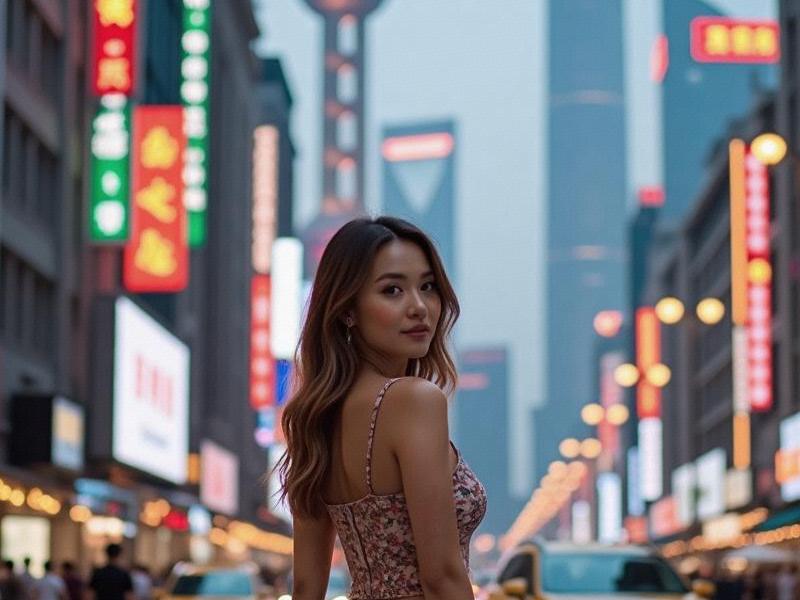Article Description: This 2,500-word feature explores Shanghai's evolving concept of female beauty through historical evolution and modern realities. From the "modern girls" of the 1930s to today's TikTok influencers, discover how Shanghai women navigate societal expectations, workplace demands, and viral aesthetics while redefining what it means to be a modern Chinese woman.

Shanghai's Modern Muse: Redefining Beauty Standards in China's Urban Powerhouse
Introduction: Beyond Aesthetics
When Western media coined the term "Shanghai Beauties" in the 1920s to DESRCIBEthe city's cosmopolitan women, they focused on bobbed hair and cheongsams. Today, this concept embodies a complex interplay of tradition and rebellion. Shanghai's women—33% of the city's workforce in STEM fields—embody contradictions: mastering guanxi (relationship-building) in business meetings while livestreaming makeup tutorials, balancing Confucian filial piety with feminist activism.
This article unpacks how Shanghai's unique position as China's financial hub and cultural bridge creates a distinct feminine identity that influences national trends.
---
Part 1: Historical Foundations
The Birth of the "Modern Girl"
In the 1920s-30s, Shanghai became Asia's first metropolitan melting pot. The city's International Settlement and French Concession created a unique space where:
- Dai Ailian, China's first prima ballerina, fused ballet with traditional fan dance
- Zhou Xuan, the "Silver Voice," popularized modern Shanghai dialect songs
- Cai Bingxing ran a photography studio capturing women in qipaos with bobbed hair
These pioneers faced backlash from conservative factions who saw bobbed hair as "un-Chinese." Their legacy lives on in today's Shanghai women who blend international trends with cultural roots.
The Mao Era Paradox
During the 1950s-70s, state propaganda promoted the "Iron Girls" (钢姑娘) image—women doing heavy labor in ships yards and factories. Shanghai's female textile workers became national icons, yet this erasure of femininity created a cultural undercurrent that resurged post-Deng Xiaoping.
---
Part 2: The New Feminine Ideal
上海贵人论坛 Workplace Elegance
Shanghai's financial district dictates a specific professional aesthetic:
- "Banker's Uniform": Tailored trousersuits with 7cm heels (average heel height in Pudong: 6.8cm vs. Beijing's 5.5cm)
- "White Collar Glow-Up": 68% of Shanghai office workers spend 15% of monthly income on skincare
- Leadership Style: CFOs like Shen Xinyi (CEO of Ping An Tech) combine sharp tailoring with "nordic minimalism" makeup
Case Study: The "Shanghai 3C" Rule
Women in leadership roles adhere to:
1. Controlled Charisma (never overtaking male colleagues in meetings)
2. Cultivated Coolness (maintaining composure during corporate crises)
3. Conspicuous Consumption (designer briefcases as status symbols)
Social Media Reinvention
TikTok (Douyin) has birthed new beauty archetypes:
- "Guochao Queens": Blending tradition with trendiness (e.g., Li Zixuan reviving 1930s cheongsam styles with holographic embroidery)
- "Work Hard Play Hard" Creators: Finance professionals posting late-night karaoke videos after IPO roadshows
- Body Positivity Advocates: Plus-size model Zhou Yating challenging 0.7 waist-to-hip ratio norms
---
Part 3: Cultural Tensions
The Filial Piety Dilemma
Shanghai women balance career ambitions with filial responsibilities:
419上海龙凤网 - "996 vs. Elder Care": 42% hire private caregivers despite cultural stigma
- Wedding Industry Pressure: Average cost of dowries in Pudong: 2.8 million yuan (vs. 1.2 million in rural Jiangxi)
- "Leftover Women" Stigma: State media campaigns clash with urban professional realities
Beauty Standards Under Scrutiny
The MeToo movement has spurred debates about cosmetic expectations:
- "Fix Your Face" (整容脸): 58% of female white-collar workers report workplace pressure to undergo double eyelid surgery
- Natural Beauty Advocates: Dermatologist Dr. Wang Meimei promotes "Shanghai Skin" (hydrated, dewy complexion) as alternative ideal
- Aging Gracefully: The "40+ Beauty" movement led by actress Xu Jinglei challenges youth obsession
---
Part 4: Global Influence
Fashion Diplomacy
Shanghai Fashion Week (2024 highlights):
- Li Xiaofei's upcycled qipaos featured at Paris Haute Couture
- Dior's AI-powered cheongsam show blended 3D embroidery with facial recognition tech
- Cross-Border Collaborations: Uniqlo's U系列 using Shanghai grandmothers' embroidery patterns
Beauty Tech Leadership
Shanghai-based companies dominate:
- Perfect Diary controls 23% of China's beauty market with Gen-Z-focused AI skincare tools
- Lanzou Tech developed the world's first AI-powered cheongsam-fitting app
上海花千坊龙凤 - Huawei's skin analysis tech now used in 4,000 Shanghai beauty salons
---
Part 5: The Future – Redefining Power
Emerging trends among Gen Alpha Shanghai girls:
1. "Tech-Savvy Confucianism": Coding bootcamps for 8-year-olds paired with calligraphy lessons
2. Financial Independence: 37% of Shanghai university students invest in crypto via Ant Group apps
3. Body Autonomy Movements: Student groups advocating for school uniform size inclusivity
Government initiatives reflect this duality:
- "Shanghai Beauty Standard" guidelines promote "healthy" BMI ranges (18.5-23.9)
- Women's Entrepreneurship Zones offer tax breaks for startups with female CEOs
- Metro Nursing Pods in Pudong provide lactation rooms and makeup mirrors
---
Conclusion: Beyond the Surface
The "Shanghai Beauty" phenomenon transcends cosmetics—it's a battleground for cultural identity in China's modernization narrative. When a fintech CEO can debate blockchain protocols in Gucci loafers, or when rural migrants become TikTok stars through beauty tutorials, Shanghai redefines both femininity and success.
Yet challenges persist. The city's 2.8 million live-streaming hosts face content censorship, while traditional "motherhood cult" pressures intensify with China's aging crisis. As the Yangtze River Delta integrates further, Shanghai's feminine identity will continue shaping—and being shaped by—national debates on equality, tradition, and technological progress.
Ultimately, Shanghai Beauties are neither stereotypes nor victims. They're architects of their own narratives, painting a vivid portrait of China's future—one perfectly contoured cheekbone and negotiated boundary at a time.
As dawn breaks over the Bund, the Oriental Pearl Tower’s rotating restaurant serves breakfast to bankers and street vendors alike—a perfect metaphor for Shanghai’s enduring magic.